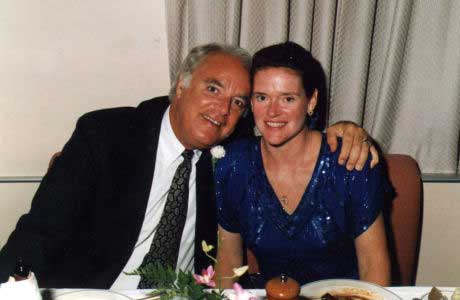|
Survivor Spotlight will continue as a regular MRF Newsletter
feature, highlighting the courage and insight of melanoma survivors.
In this issue we spotlight Kim Schofield Wheeler (pictured below with
husband Dick).

I have been asked to write my story for this newsletter with
the intent of offering some hope and strength for those having to
battle melanoma.
I was 19 years old when I first went to a doctor because of a
large, bleeding mole on the back of my right calf.
At the time, I had never even heard of melanoma.
This was in 1975. The primary was excised, misdiagnosed by two
pathology departments and, as a result, nothing more was done.
In my visit the following year, enlarged lymph nodes in my groin were
discovered, a local biopsy was performed and malignant cells were found.
A radical node dissection was performed and due to the amount of
positive nodes, I was diagnosed as Stage IV. I really didn't realize
the implications. This was before Clark and Breslow levels were used
for diagnosing primaries, no statistics were known by me and I was
just learning about the disease called melanoma.
At the time of my node surgery in 1976, I was fortunate to be a
patient of a physician who was trying a new vaccine combination of
MER and BCG. I was the youngest melanoma patient he had ever seen.
He was Malcolm Mitchell, M.D., a now world renowned physician known
for his work with vaccines.
That began the start, of what seems to me, of always being in
the right place at the right time whenever I had a recurrence.
In order, since 1976, I have had a radical groin node dissection,
6 months of MER/BCG injections, 12 months of Cytoxan and DTIC, an
Isolated Limb Perfusion (ILP) on my right leg with Nitrogen Mustards,
multiple surgeries to remove cutaneous melanomas, Intra-arterial
infusions of Cisplatinum and DTIC for right leg lesions, multiple
surgeries to remove subcutaneous (subq) tumors below the right knee, 12
months of high dose Interferon injected directly into 17 subcutaneous tumors
on the right leg, resected bone metastasis (met) in the right elbow with
radiation and chemo-infusion treatments, radiation for bone mets in my
left knee and left ankle, 6 months of an autologous vaccine for
multiple subq tumors on torso and extremities, the GP100 vaccine and
high dose IL2 for subq tumors and bone met in my right elbow, and the
peptide vaccine and high dose IL2 for a bone met in my right ulna. This
last bone met in my right ulna was the most stubborn I have ever had.
Until this tumor, all my tumors had responded well to the above
treatments and surgeries. For some reason, this new tumor had
"mutated" to the point of not responding to any treatments.
In April, 1998, I underwent surgery to have the 10cmx7cm tumor (about
the size of a baseball) removed and to have an implant connecting my
ulna to my humerus to replace 5 inches of bone that the tumor had eaten
away. At the time of this writing, April, 1999, I have had since the
fall of 1997, my sixth bone tumor in my right upper tibia (shin). I
have had no treatment or surgery yet, as the tumor seems to be
regressing on its own.
During these years, I have completed college, have had two children,
and have built a rewarding career. I am no superstar and certainly
don't stand out any differently than anyone else in this world.
However, I feel that my attitude and positive outlook on life have
gotten me this far and will keep me going for much longer. Some
physicians say I have a unique immune system that is stronger than the
disease most of the time, but that needs a boost every once in a while.
Some physicians say it is my attitude. Some others just scratch their
heads. I think it is a combination of my attitude, my immune system, my
treatments and the great support from my family. I also think I have
been lucky to have had great physicians who care about beating this
disease, Malcolm Mitchell, Charles Vogel, Charles McBride, Robert
Benjamin, Omar Eton, Steven Rosenberg and Martin Malawer, to name a
few. With physicians like these and others, melanoma patients are being
given the chance to beat the odds at an increasingly greater pace.
As a result of my 24 years of fighting this disease, I would like to
pass along one more point. You are your own best advocate for beating
this disease. You should not rely solely on one physician or on one
institution for your treatment. As difficult as it is to accept, the
medical community does not have all the answers. There are numerous
programs underway all over the world looking for solutions and each
program is different. Your obligation to yourself is to seek out
information on as many of these programs as possible and to investigate
their results as potential options for your current or future
treatment. As an example, when I had the tumor removed last year, I had
it shipped to UCSF where it was frozen for future use in an autogolous
vaccine. You need to think ahead and plan accordingly. I have nothing
but the greatest respect for the physicians and researchers who have
provided me with life saving treatments, but even these pioneers have
recommended that I search for other treatments as alternatives. The
Internet, cancer group discussion lists and many other support and
information groups can give you a starting point for your
investigation. You need to develop a network of "friends" who
have or know someone who has melanoma. You need to be persistent in
your quest for what is the right treatment or treatments for you.
|
This newsletter is published by:
|
Melanoma Research Foundation
170 Township Line Road
Building B, First Floor
Hillsborough, NJ 08844
www.melanoma.org
Email:
mrf@melanoma.org
|
|
|